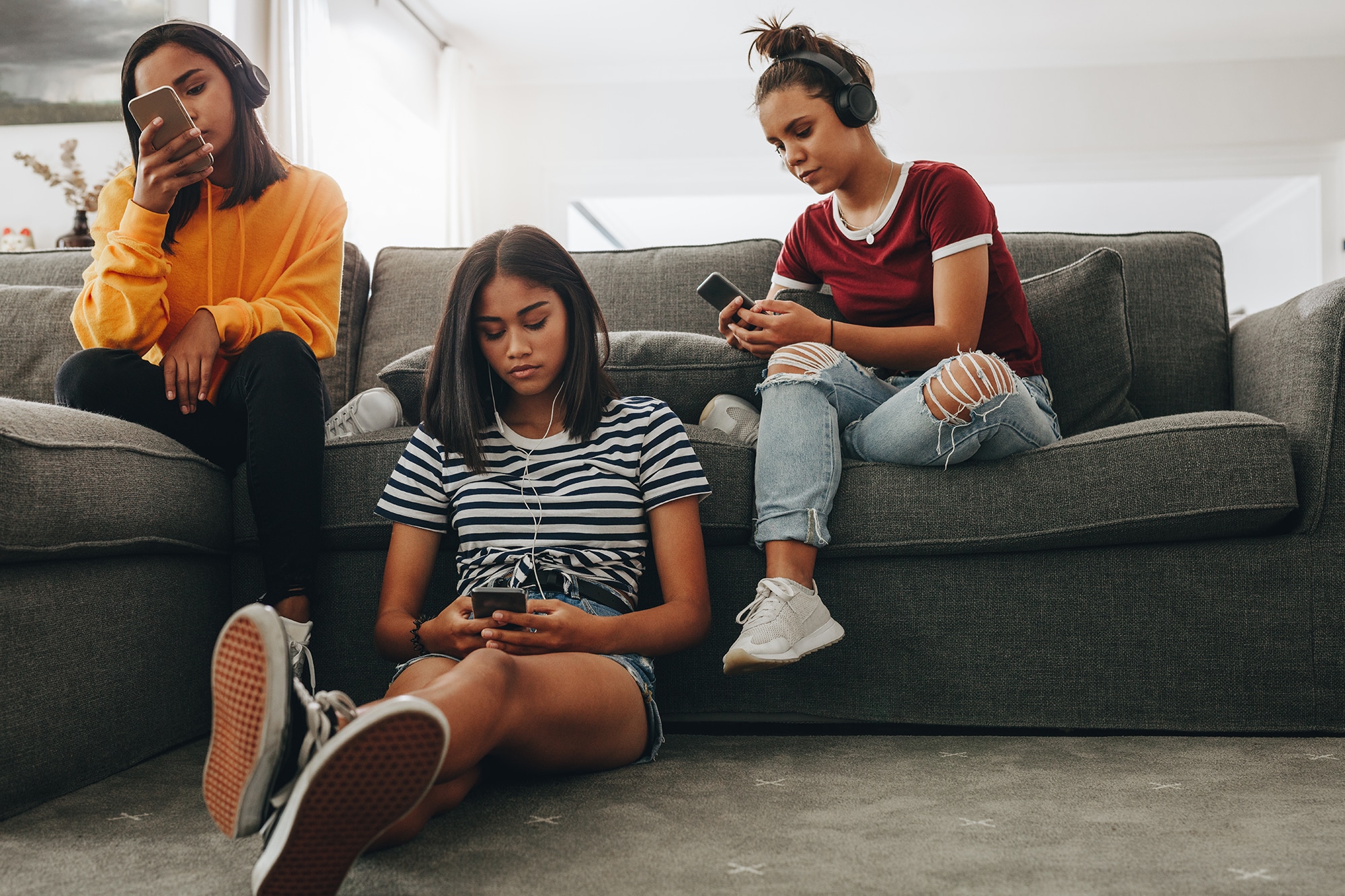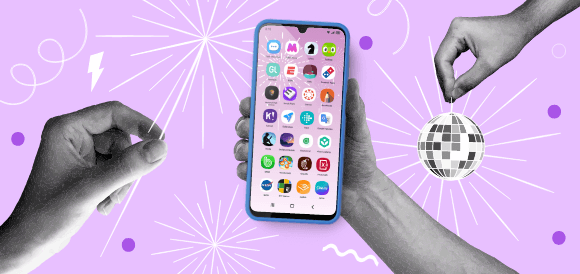It’s normal to feel shy, lonely, reserved, or introverted in social situations. But for many children, these characteristics may be indicative of social anxiety (social phobia). The concern many parents now face with the rising prevalence of technology and availability to social media platforms is that their children will substitute face-to-face interactions for virtual ones. Cell phones give many adolescents constant access to social media and messaging services, which enable them to communicate and share content at any time or place.
Many kids with social anxiety may develop a dysfunctional attachment to their phones because of the safety associated with their devices (Annoni, 2021). Research has shown that people with social anxiety are at risk of developing compulsive or even addictive technology habits (Turgeman, 2020). They may be inadvertently reducing their quality of life and the quality of interpersonal relationships. This disorder can reflect negatively in work and school environments and interfere with personal relationships (Turgeman, 2020). But no matter how many followers they may have on social media, it’s the quality of those relationships that are important.
What is Social Anxiety?
Social anxiety is a mental health condition closely related to general anxiety but focuses more specifically on individual responses to social situations, characterized by an intense fear of being watched, humiliated, judged, rejected, embarrassed, or scrutinized by others in public settings (Mayo Clinic, 2021; U.S. Department of Health).
Anxiety can occur in response to planned and unplanned events, usually sparked by real-life situations and extending to imaginary scenarios the child creates in anticipation of what could happen (Gao, 2016). Children make these stressful connections between themselves and the rest of the world and interpret social events as hostile environments (Annoni, 2021). What typically happens, as a result, is kids isolate themselves and actively avoid social situations to ease this anxiety. Not only does this reduce their general quality of life, but it can be debilitating in extreme cases (Hur, 2021).
An estimated 9.1% of adolescents have social anxiety disorder, and an estimated 1.3% have severe impairment.
—U.S. Department of Health and Human Services
Research suggests that social anxiety develops in children from a young age. Some children are naturally predisposed to feel emotional distress and withdraw from unfamiliar or intimidating situations, objects, and people. The National Institutes of Mental Health cite that “an estimated 9.1% of adolescents have social anxiety disorder, and an estimated 1.3% have severe impairment” (U.S. Department of Health and Human Services, n.d.).
Sometimes children prone to this sensitivity won’t develop age-appropriate social skills, self-awareness, confidence, or social problem-solving strategies because of a lack of socialization with peers. Additionally, they may eventually rely on social withdrawal as a coping mechanism that can extend to include consistent avoidance of familiar social contexts. However, socially withdrawn children are not always prone to social anxiety (Chronis-Tuscano, 2018). This means that, if caught early on, this disorder may be preventable. Older children who have already developed and suffer from social anxiety should consider treatment methods such as psychotherapy (also known as talk therapy), support groups, and possibly prescribed medications, as directed by a licensed physician (U.S. Department of Health).
Hiding Behind the Screen

Young adults often turn to technology for comfort as they enter this phase of life. For the first time, they experience social situations under the assumption that they are equipped with the skills to function appropriately. However, their social anxiety leaves them ill-equipped to handle these expectations. Very quickly, smartphones become a safe place for controlled communication as the teen removes the unpredictability of face-to-face interactions (Annoni, 2021). Their phone becomes a shield they can hide behind for protection and self-preservation. It gives them the space to disengage from the overwhelming aspects of real-time conversation and take the time to refocus on how to respond (Reid, 2007).
As a result, those with social anxiety are more likely to rely on social media to mitigate the way they present themselves to others and influence how they build relationships. When observing your child’s in-person social behavior compared to online social engagement, watch for the tendency to avoid face-to-face interaction rather than relying on a digital connection.
Creating an Online Persona
Social anxiety is characterized by a fear of not being able to perform adequately in social situations and that, as a result, those we interact with will perceive us negatively. When these same interactions happen on a virtual platform, the child has more control over how others may view their appearance and behavior; it makes social encounters lower risk (Turgeman, 2020). Smartphones and Internet mediums put a physical barrier between the socially anxious child and the rest of the world. One possible result is that they can be bolder, braver, and more confident than they are off-screen. They adopt an online persona, expressing themselves differently than they would in real life (Reid, 2007).
Essentially, socially anxious children can maintain control over situations by presenting themselves any way they want, while still reaping the benefits of social interaction with reduced fear of judgment and rejection. Although using this mode of communication can be beneficial, we want to help those who feel this anxiety build the skills necessary to be ‘bilingual’ or able to communicate in both modalities. Like learning a new language, it will take exposure to in-person social interactions to build that competency. It will not always be comfortable, but over time the skills of in-person communication can be formed and strengthened.
Putting Personal Relationships at Arm’s Length
Socially anxious individuals believe that their relationships are of a lower quality, and worry that they are annoying others by being too needy or over-reliant. These beliefs cause resistance to forming close relationships or a trusted support system, and many turn to online connections instead.
—Dr. Juyoen Hur, Department of Psychology, University of Maryland, College Park
Intrusive thought patterns lead socially anxious kids to believe that those around them don’t socially support them, that their relationships are of a lower quality, and worry that they are annoying others by being too needy or over-reliant (Hur, 2020). These beliefs cause resistance to forming close relationships or a trusted support system, so those suffering from social anxiety will turn to online connections instead. Research shows that socially anxious children have much smaller personal social networks than the average person, spending more time alone than with close friends or family (Hur, 2020).
As a result of pushing away personal, real-life relationships, these children turn to virtual relationships to fill this gap. Studies show they are compensating for the lack of face-to-face relationships and the difficulty they experience with maintaining the personal relationships that they do have (Annoni, 2021; Hur, 2020). Parents of socially anxious children will see this manifested in a lack of trust in others and a retreat into technology where anonymity allows them to be vulnerable in an environment they can control.
Technology Is a Double Edged Sword
The way socially anxious kids use technology to navigate their lives is complex as it is both beneficial and harmful. While it may help them freely communicate, it may also exacerbate their social isolation by further distancing them from the offline world (Turgeman, 2020). In other words, using technology as a buffer doesn’t work as a permanent solution. Another concern is that in a virtual platform they can find acceptance and express themselves safely, often in stark contrast to the negative experiences they have in the offline world. This only reinforces social withdrawal and increases their fear. Being online may prove to be easier temporarily, but will stunt their aptitude at living outside the screen.
On the one hand, allowing socially anxious children and adolescents to use technology will give them access to a community where they can feel comfortable to push the boundaries of their identities without as much fear of judgment. They may have a greater chance to find support from people who understand what they are going through. On the other hand, this may enable them to persist in their socially anxious behaviors. It is not a cure, but more of a crutch. Taking it away altogether may not be a solution—in many ways, this has become their support system. This is their network and community of people with whom they have developed relationships. But they also need to be encouraged to step away from the screen and interact in the real world—something that will feel very uncomfortable to them.
So, How Can You Help Your Child?
Be aware of patterns
For parents, the main thing to pay attention to is whether you are unintentionally reinforcing your child’s social withdrawal by adjusting the way you respond and treat them in an effort to minimize their discomfort in social situations (Chronis-Tuscano, 2018). Children who feel distressed in social situations will naturally turn to their parents for help, and parents instinctually try to come to the rescue. Over time, parents will come to anticipate their child’s response to social stimuli and may react in an over-protective, directive, and controlling way (Chronis-Tuscano, 2018). Not only will parents come to see their children as vulnerable and in need of protection, but the child will come to be dependent on their parents because they are unable to handle social situations on their own.
Help your child build a strong support system and a safe offline environment

The best approach to helping a child overcome their social anxiety is to respond to them with warmth, sensitivity, and gentle encouragement when faced with unfamiliar social situations (Chronis-Tuscano, 2018). It’s important to expose them to these situations and allow them to learn the appropriate coping skills that have gone underdeveloped over time. There needs to be a balance between taking a step back so they can navigate social interactions on their own and making sure they feel supported and safe.
The goal is to help them become more adaptive, independent, confident, and self-assured (Hur, 2020). Having close friendships and strong family relationships both aid in nurturing the development of these skills and in normalizing anxious behaviors in social contexts by providing safe social connections, acceptance, and support (Hur, 2020). This network of support is a vital and healthy way for children to manage social situations. In addition to professionally recommended medical treatment, family and friends are crucial in helping socially anxious children break away from the online world and find fulfillment in real life.
References
- Annoni, A. M., Petrocchi, S., Camerini, A.-L., & Marciano, L. (2021). The relationship between social Anxiety, smartphone Use, DISPOSITIONAL trust, and problematic Smartphone use: A moderated Mediation Model. International Journal of Environmental Research and Public Health, 18(5). https://doi.org/10.3390/ijerph18052452
- Chronis-Tuscano, A., Danko, C. M., Rubin, K. H., Coplan, R. J., & Novick, D. R. (2018). Future directions for research on early intervention for young children at risk for social anxiety. Journal of Clinical Child & Adolescent Psychology, 47(4). https://doi.org/10.1080/15374416.2018.1426006
- Gao, Y., Li, A., Zhu, T., Liu, X., & Liu, X. (2016). How smartphone usage correlates with social anxiety and loneliness. PeerJ, 4. https://doi.org/10.7717/peerj.2197
- Hur, J., DeYoung, K. A., Islam, S., Anderson, A. S., Barstead, M. G., & Shackman, A. J. (2020). Social context and the real-world consequences of social anxiety. Psychological Medicine, 50(12), 1989–2000. https://doi.org/10.1017/s0033291719002022
- Mayo Foundation for Medical Education and Research. (2021, June 19). Social anxiety disorder (social phobia). Social Anxiety Disorder. Retrieved September 10, 2021, from https://www.mayoclinic.org/diseases-conditions/social-anxiety-disorder/symptoms-causes/syc-20353561
- Reid, D. J., & Reid, F. J. M. (2007). Text or TALK? Social anxiety, loneliness, and Divergent preferences for cell phone use. CyberPsychology & Behavior, 10(3). https://doi.org/10.1089/cpb.2006.9936
- Turgeman, L., Hefner, I., Bazon, M., Yehoshua, O., & Weinstein, A. (2020, February 15). Studies on the relationship between social anxiety and Excessive smartphone use and on the effects of abstinence and sensation seeking on Excessive smartphone use. MDPI. Retrieved September 10, 2021. https://doi.org/10.3390/ijerph17041262
- U.S. Department of Health and Human Services. (2016). Social anxiety disorder: More than just shyness. National Institute of Mental Health. https://www.nimh.nih.gov/health/publications/social-anxiety-disorder-more-than-just-shyness
- U.S. Department of Health and Human Services. (n.d.). NIMH " social anxiety disorder. National Institute of Mental Health. Retrieved November 4, 2021, from https://www.nimh.nih.gov/health/statistics/social-anxiety-disorder












Success!
Your comment has been submitted for review! We will notify you when it has been approved and posted!
Thank you!